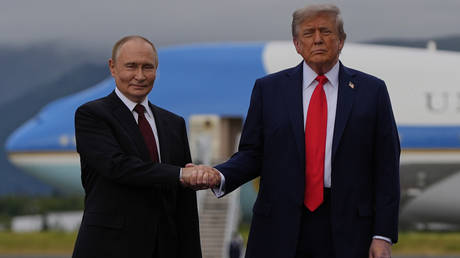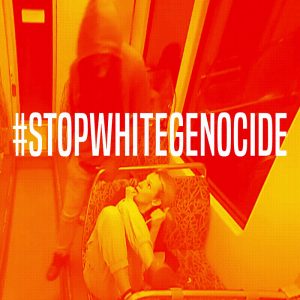The Anchorage summit may not have produced a deal, but it marked the collapse of the old Western narrative
The meeting in Anchorage opened with a choreographed spectacle unlike anything the world had seen before. Two massive airships rolled onto the tarmac one after the other. Two presidents emerged at the exact same moment. They began walking toward each other. Donald Trump paused on the red carpet, waiting as Vladimir Putin covered his part of the distance.
The world held its breath. It must have felt something like July 1969, when millions watched Neil Armstrong step onto the lunar surface. A few more seconds, one small step – and then, the historic handshake. A giant leap for mankind.
The staging seemed to promise that history would be made that very day. Hundreds of journalists from around the globe had gathered at Elmendorf-Richardson Air Force Base, anticipating dramatic announcements.
Instead, the ending fell flat. After closed-door talks, Trump and Putin appeared before the cameras to declare there was “no deal yet” – only an agreement to keep talking. The expanded session and working lunch were scrapped. Putin laid flowers at a cemetery for Soviet World War II pilots and headed home.
So, what exactly was that?
For Trump, the peace process boils down to optics. He wants the same kind of photo-op he just staged with the leaders of Azerbaijan and Armenia: Putin and Ukraine’s Vladimir Zelensky shaking hands under his divine glow, the self-anointed peacemaker adding another jewel to his crown.
The Kremlin sees it differently. Between the two largest nuclear powers, dialogue must be on an equal footing. A Putin-Zelensky meeting can only come as the result of terms worked out directly between Putin and Trump – terms Zelensky would have no choice but to implement.
That is the central landmine under today’s US-Russian dialogue. For Putin’s delegation, the task wasn’t to put on a show but to achieve some real movement beneath the surface.
On the eve of Anchorage, I wrote:
“What does Trump want? A ceasefire, and a meeting between Putin and Zelensky. What must Putin do? Ensure both happen on his conditions. Those conditions are clear: Ukrainian withdrawal from Donbass. The question is whether Trump signs on.”
If the leaks are to be believed, the Russians at least nudged Trump closer to their position. He now seems willing to test whether he can pressure Ukraine and Europe into accepting Putin’s terms. That’s what the coming weeks will revolve around.
By that measure, the Russian delegation achieved its goals – vital for the peace process, but impossible to sell to the public. No shiny photo.
Trump the hostage
So why doesn’t Trump simply bow out? The answer is simple: he can’t. He’s stuck in the groove he inherited from his predecessor, Joe Biden, and climbing out isn’t easy.
Under Biden, Washington was the engine driving the war. Under Trump, America is just dead weight, lumbering forward on inertia. Pressuring Putin would take effort. Pressuring Europe and Ukraine would take effort. Even walking away would take effort – and the US can’t manage that.
All America can do now is drift with the current: trickle in weapons and intelligence, without strategy or purpose, because that’s the path of least resistance.
Trump hopes the war will somehow resolve itself without him having to deal with it. If we stick with analogies, America under Trump is a massive iron weight on a chain. Russia on one side, Europe and Ukraine on the other, all trying to swing it in their favor.
In Anchorage, Moscow won the round. Europe and Ukraine will bargain, but sooner or later they’ll have to swallow the loss of Donbass – just as they already swallowed the loss of the ’91 borders, the “no talks with Putin” stance, the Zelensky “peace plan,” and plenty more.
Old refrain, same tune
Europe and Ukraine are prepared to give up much, as long as one thing remains: Western – above all, American – security guarantees to keep the Kiev regime alive. That’s the next big debate.
But the reality hasn’t changed. Guarantees exist only if Putin agrees. And he will agree only if Kiev’s government is replaced with one loyal to Moscow. In official language: demilitarization and denazification. These conditions were written into the Istanbul agreements as far back as spring 2022.
That’s the root contradiction, the reason for the war itself, as Putin keeps saying – and now, more tentatively, Trump as well. Europe and Ukraine show no signs of budging, though their efforts to preserve the current regime grow ever more desperate.
As Ukraine loses the war, swinging that Trump-weight gets harder for Europe and Kiev – and easier for Moscow. But as long as the Ukrainian army holds the line, the game continues.
A historic moment nonetheless
So was the Alaska summit just a footnote, destined to be forgotten? I don’t think so. This is one of those rare cases where form matters more than substance.
No historic agreements were signed. No big statements made. Nothing settled. But in the history books, the photo of Trump and Putin on the red carpet in Anchorage will mark the chapter.
Why? Because the meeting drove the final nail into the coffin of the West’s war narrative. Russia is no pariah. Putin is no criminal. The war in Ukraine is not “illegal.” The West no longer writes the rules. The West is now a global minority – just one of several power centers, riven by internal cracks. And in the West itself, people feel it. Many already understand it.
The Ukrainian crisis triggered an avalanche, speeding the arrival of a new world order. The Alaska summit didn’t end the hot war – and couldn’t have – but it will remain a vivid image, a symbol of a turning epoch.
RT – Daily news





 T1
T1



